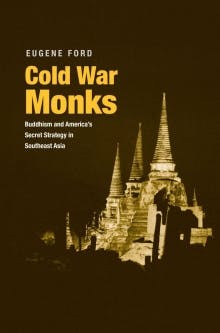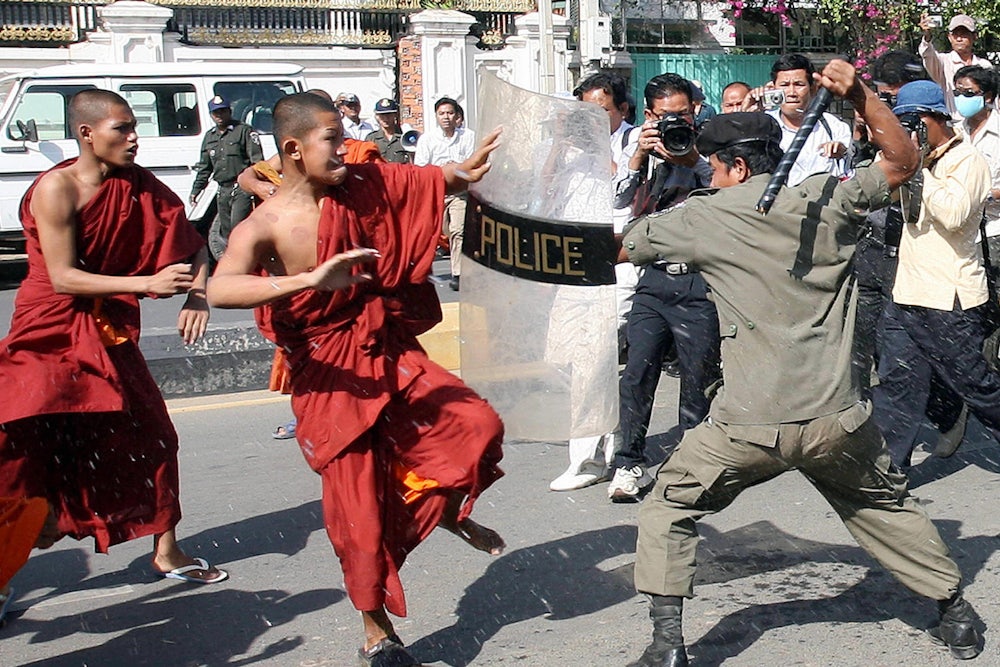Of the world’s major faiths, Buddhism is often characterized as being a religion of peace, tolerance, and compassion. The Western encounter with Buddhism has largely been distilled through yoga, the beatniks, Hollywood, and Dalai Lama quotes shared on Facebook. But even a cursory glance at the news that emanates from the Buddhist world reveals a more sanguinary state of affairs.
In Myanmar, ultra-nationalist monks have fueled a genocidal crusade against the country’s Rohingya Muslim population. In Thailand, the government has responded to a long-running Malay Muslim insurgency in its southern provinces by fostering a Buddhist militarism, encouraging monks in local temples to ally with the armed forces. And in Sri Lanka, the Buddhist-majority Sinhalese were engaged in a bitter civil war against the Hindu-minority Tamils for decades. More recently, Buddhist nationalists there have stoked anti-Muslim riots.

Still, Buddhism continues to have an alien aura, as if it were an “entirely otherworldly religion with a gnostic distaste for the worldly order,” as the scholar Ian Harris has written. There is a tendency to frame the rise of Buddhist nationalism as an anomalous phenomenon. In fact, as the historian Eugene Ford shows in his book Cold War Monks: Buddhism and America’s Secret Strategy in Southeast Asia, the Buddhist world was a laboratory of competing visions and ideologies in the Cold War—an experiment that helped politicize Buddhism into the often violent, reactionary force we see in Southeast Asia today.
Buddhism and statecraft have long been joined at the hip. The religion supplied the symbols of kingship in courts, capitals, and urban centers from Burma (now Myanmar) to Siam (Thailand) to Laos, as monastic orders and ruling elites forged intimate ties. Following the seventeenth century, European imperialism disrupted the symbiosis of religion and state in places where colonial regimes were installed. By the early half of the twentieth century, anti-colonial movements saw monks participate in dissent, laying the foundations for the clergy to enter secular affairs.
The exception was Thailand, the only country in the region to avoid formal colonization. It was a distinction that shaped its nationalist narrative, which glorified the monarchy while sheltering its monks from the activism of their counterparts in neighboring countries. However, during World War II, imperial Japan’s occupation of Bangkok offered a harbinger of the outside pressures that would be released upon Buddhism in the postwar era. Tsusho Byoto, an obscure Japanese scholar-monk, advocated a militarized conception of Zen in an attempt to recruit the guarded Thai monastic order to the fascist cause. While he ultimately failed, Byoto’s “vision of an internationalized Thai monkhood would in many ways prove prophetic,” Ford writes.
The immediate postwar aftermath saw revolutionary nationalist movements proliferate from Indonesia to Vietnam, guided by an anti-colonial ethos informed by Marxism. Colonial powers waged costly and ultimately doomed counterrevolutionary wars to reestablish control, which then dovetailed with the U.S.’s anti-communist efforts as Europe withdrew from the scene.
A military-strategic alliance with the U.S. became the central pillar of Thailand’s foreign relations after 1947, drawing the rest of Southeast Asia into a turbulent geopolitical orbit. The partnership early on faced two challenges: Thailand had to keep up the appearance that the conservative monkhood was segregated from the political realm, while adherence to the First Amendment prevented any direct U.S. involvement in Thailand’s religious affairs. All this did was compel Washington to operate clandestinely, as it began to shape a pliable Buddhist bloc that would act as its proxy.
The gravitational forces of the Cold War would cause the Buddhist clergy to become more politicized and more internationalized than ever before. In 1953, during the Eisenhower administration, Vice President Richard Nixon undertook a formative trip across Asia. In Vietnam, Nixon visited the front lines of the Indochina Wars to witness a French offensive against Viet Minh insurgents. He was frustrated by France’s patronizing attitude toward its Vietnamese allies, and disturbed by a failure to establish a legitimate cause to counter the stirring appeal of their anti-colonial adversaries.
The defeat of the French at Dien Bien Phu in 1954 then made it clear that military action itself was insufficient to combat communism in the region. Hearts and minds—or, pagodas and temples—were going to be just as essential. Religion, Ford says, “was a lever the United States could use to wield influence of a nonmilitary or psychological nature, not least by emphasizing to local populations the supposed communist threat to their religious institutions.”
Coinciding with Washington’s strategy at the time was the emergence of a pan-Buddhist consciousness. Advancements in communication and transportation had accelerated religious and cultural exchange and deepened interconnectivity within the milieu of Theravada Buddhism, the predominant strain of Buddhism in Southeast Asia. The 2,500th anniversary of the Buddha’s death inspired the launch of the first international Buddhist organization in 1950: the World Fellowship of Buddhists. Coupled with the 1954 staging of the Great Buddhist Synod in Burma, there were signs that the consolidation of a Buddhist bloc was ripe for engagement.
The earliest of U.S. efforts began in Burma between 1951 and 1952. Burma’s Prime Minister U Nu had been battling a domestic communist insurgency since 1948 and looked to incorporate “Burmese Buddhism” into an anti-communist program. This was well received by Washington, as conveyed by a 1951 State Department memo to its embassy in Rangoon. The memo highlighted the rules of engagement as it applied to U.S. funding of religious activities, which had to be undertaken through private channels to obscure any official links.
The CIA deepened such activity across the region. As early as 1948, it harvested intelligence on Bangkok’s Vietnamese monasteries to monitor for potential communist links. At the invitation of the U Nu government, the Committee for a Free Asia—which was renamed the Asia Foundation in 1954—became active in Burma in 1952, bankrolled by the CIA through the National Committee for a Free Europe. (Much of Ford’s archival sources come from the Asia Foundation.) The Asia Foundation had extensive behind-the-scenes involvement in the Great Buddhist Synod. By 1962, Ford notes, it had contributed over $300,000 in the form of original printing equipment and technical advice to make “Burma’s Buddha Sasana Press the world’s largest and best equipped Buddhist publishing house.”
The Asia Foundation would then expand its operations into neighboring Thailand, Cambodia, and Laos. Harnessing the foundation’s platform and networks in the region, Washington provided grants to Buddhist educational and civic groups, and distributed anti-communist propaganda. It also made sure to send (unofficial) delegations to Buddhist conferences while sponsoring trips for senior members of the Buddhist community to the U.S.
By 1957, White House policy-makers had produced a general policy framework geared towards the manipulation of Buddhist institutions and monks. The draft was circulated within U.S. embassies across Southeast Asia, and even a special “Buddhist Committee” was formed in the State Department to assist its implementation. By emphasizing community activism, Ford writes that the Asia Foundation’s “aim had been to preserve the monkhood’s traditional abstention from politics by providing alternative forms of civic engagement.” Much like Byoto, the Asia Foundation resembled a foreign agent determined on restructuring Thailand’s cloistered Buddhist institutions.
As turmoil enveloped Southeast Asia, however, the strategy began to unravel, as forces that were activated failed to align as intended.
A coup d’état deposed Burma’s U Nu in 1962, and the military junta engaged in a protracted campaign against a local communist insurgency. The repression of Buddhists under the U.S.-supported Catholic leader Ngo Dinh Diem in Vietnam during the “Buddhist Crisis,” and the self-immolation of the monk Quang Duc in 1963, hastened a political crisis that culminated in a military coup, Diem’s assassination, and the further spiraling of South Vietnam into chaos. In 1967, the Asia Foundation’s CIA patronage was exposed in the antiwar journal Ramparts. Eventually, despite U.S. military aid and religious sponsorship, communists took power in Laos and Cambodia in 1975. That same year, Saigon fell to the Viet Cong.
With the specter of communism at its doorstep, the Thai conservative establishment curbed the postwar experiment of civilian democratic rule in its quest for stability. It achieved this by soliciting the services of a notorious right-wing monk named Kittivudho, who to Ford represented “both the activation and the internationalization of Thai Buddhist conservatism.” By incentivizing the assassination of leftists with accumulation of religious merit, Kittivudho fused Buddhist doctrine with a virulent anti-communism. He lent institutional support to right-wing paramilitary organizations and vigilante groups, as the Thai government (with implicit support from Washington) carried out a brutal crackdown on students, labor activists, and farmers.
Cold War Monks alerts readers to the ways in which the volatile currents of the Cold War swept up Southeast Asian Buddhism. What was an ultimately unsuccessful effort to draw the monkhood out of its political quietism swiftly mutated into an anti-progressive force, and continued to endure as a dark cloud over the region’s politics in subsequent decades.
This bloody legacy echoes in the present. It can be detected in the violent response of Thai monks to the Malay Muslim insurgency in the south, a campaign that has many similarities with Myanmar’s clerical-led anti-Muslim 969 movement. Under the pressures exerted by globalization, Buddhism continues to provide a source of legitimacy for nation-states across the region. Its followers are susceptible to battle cries to preserve the faith under the banner of a muscular Buddhist nationalism.
The termination of the Cold War did not erase the imprint of a more bellicose Buddhism. Only instead of a godless communism, now it is a transnational militant Islam that is envisioned as a threat to Buddhist identity and tradition. This ideological shift just so happens to coincide with the U.S.’s “war on terror,” which has been operationalized to justify the bloody reprisals in Thailand and the pogroms in Myanmar. And the monks are front and center of it all.
